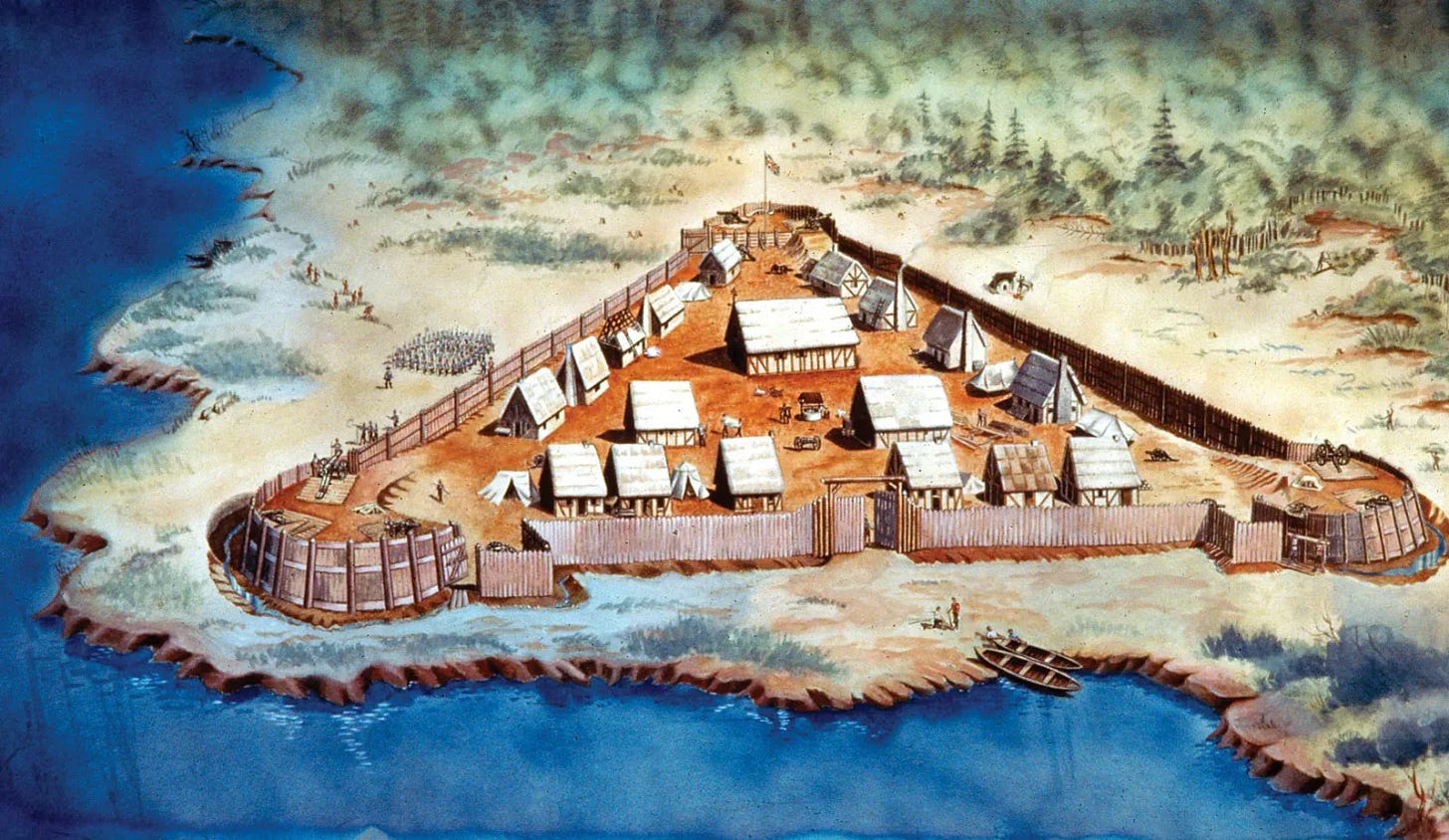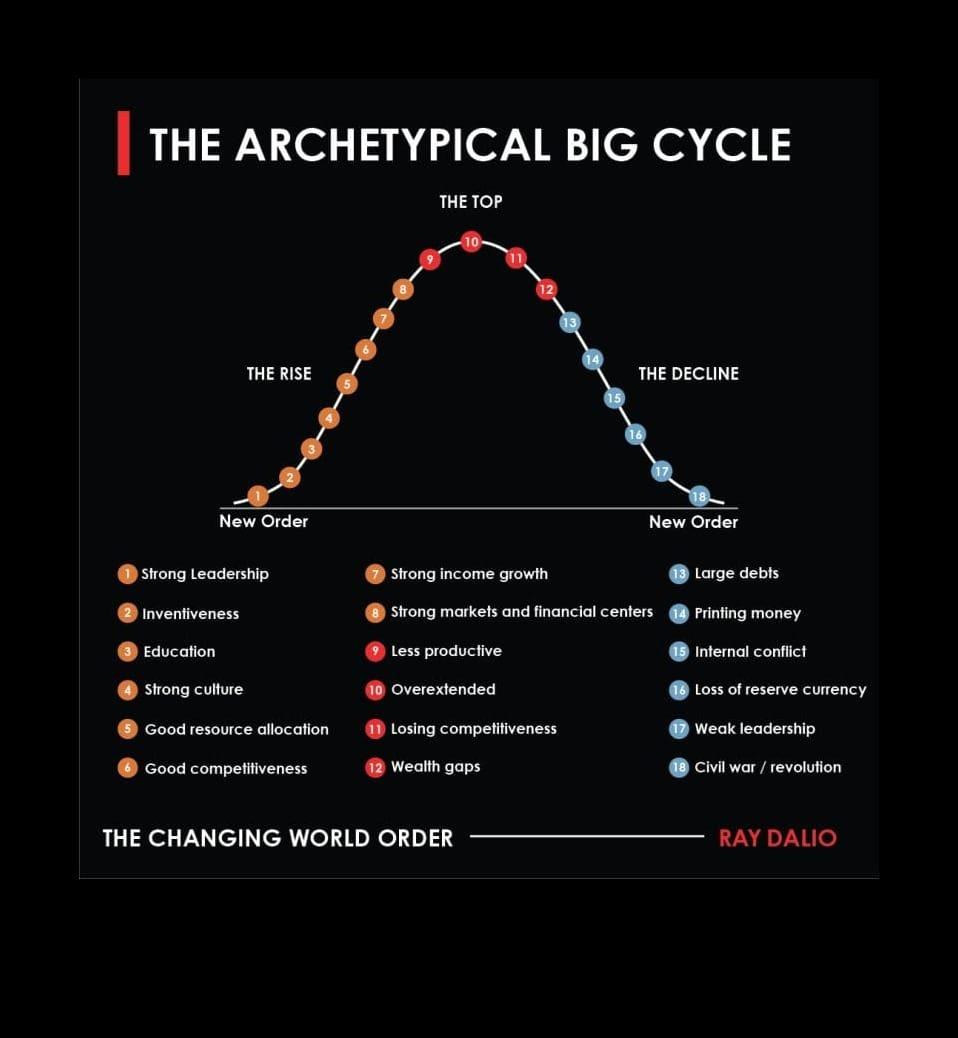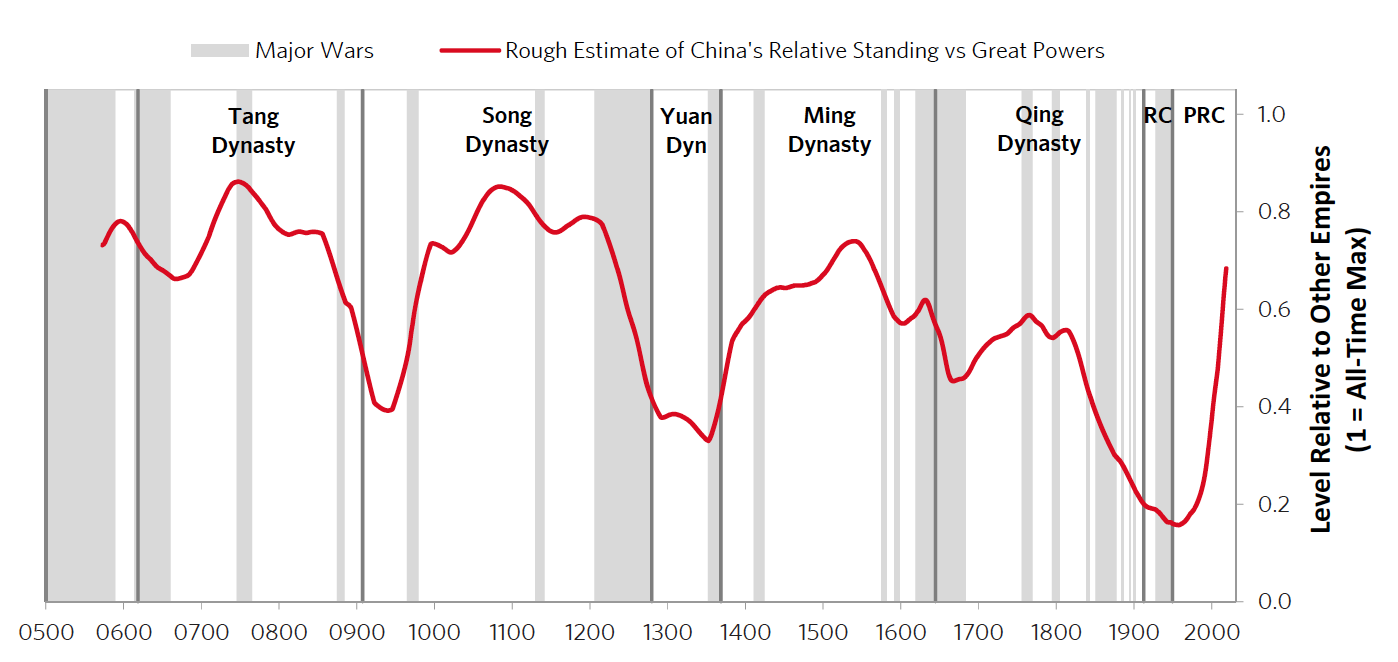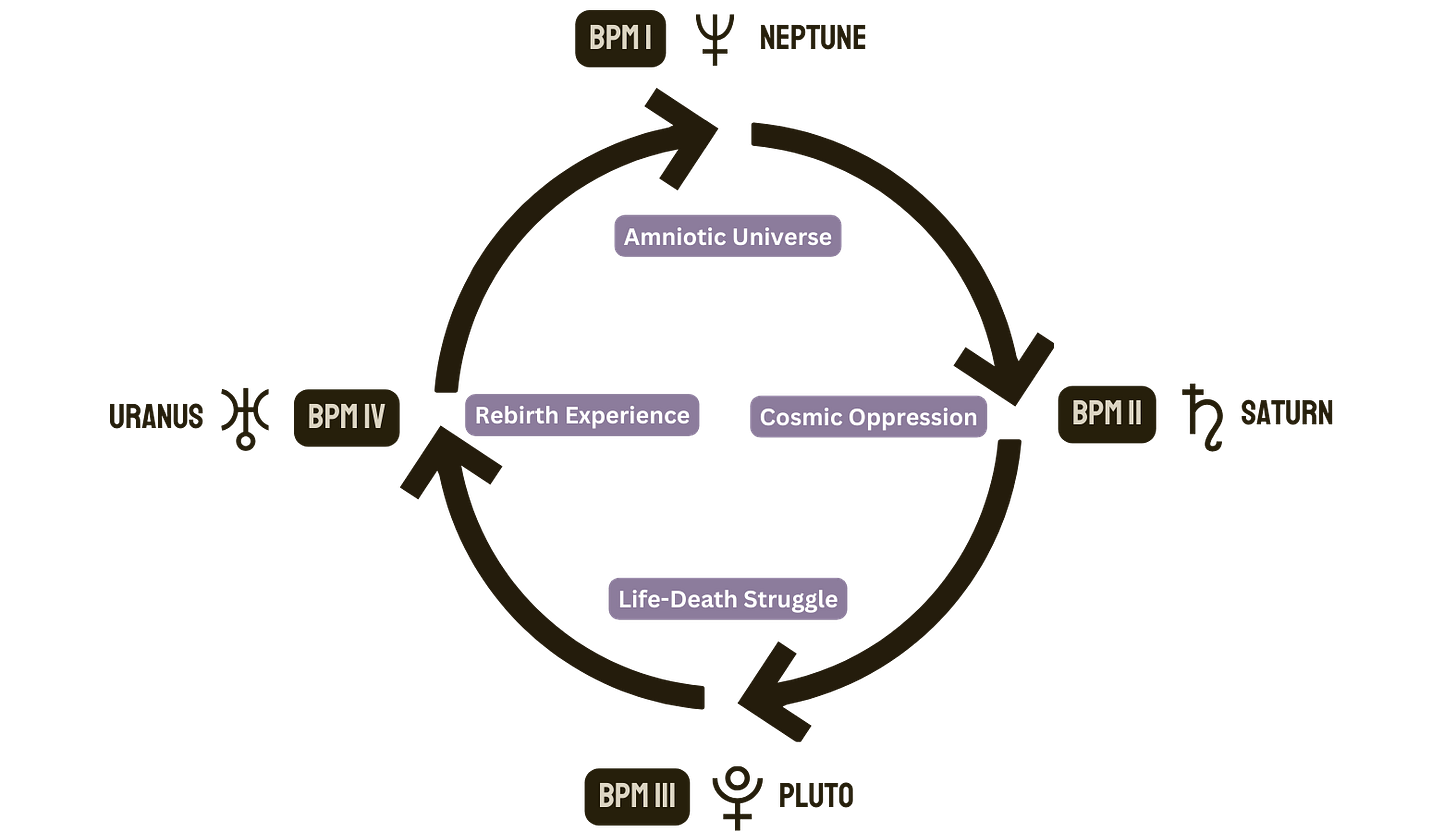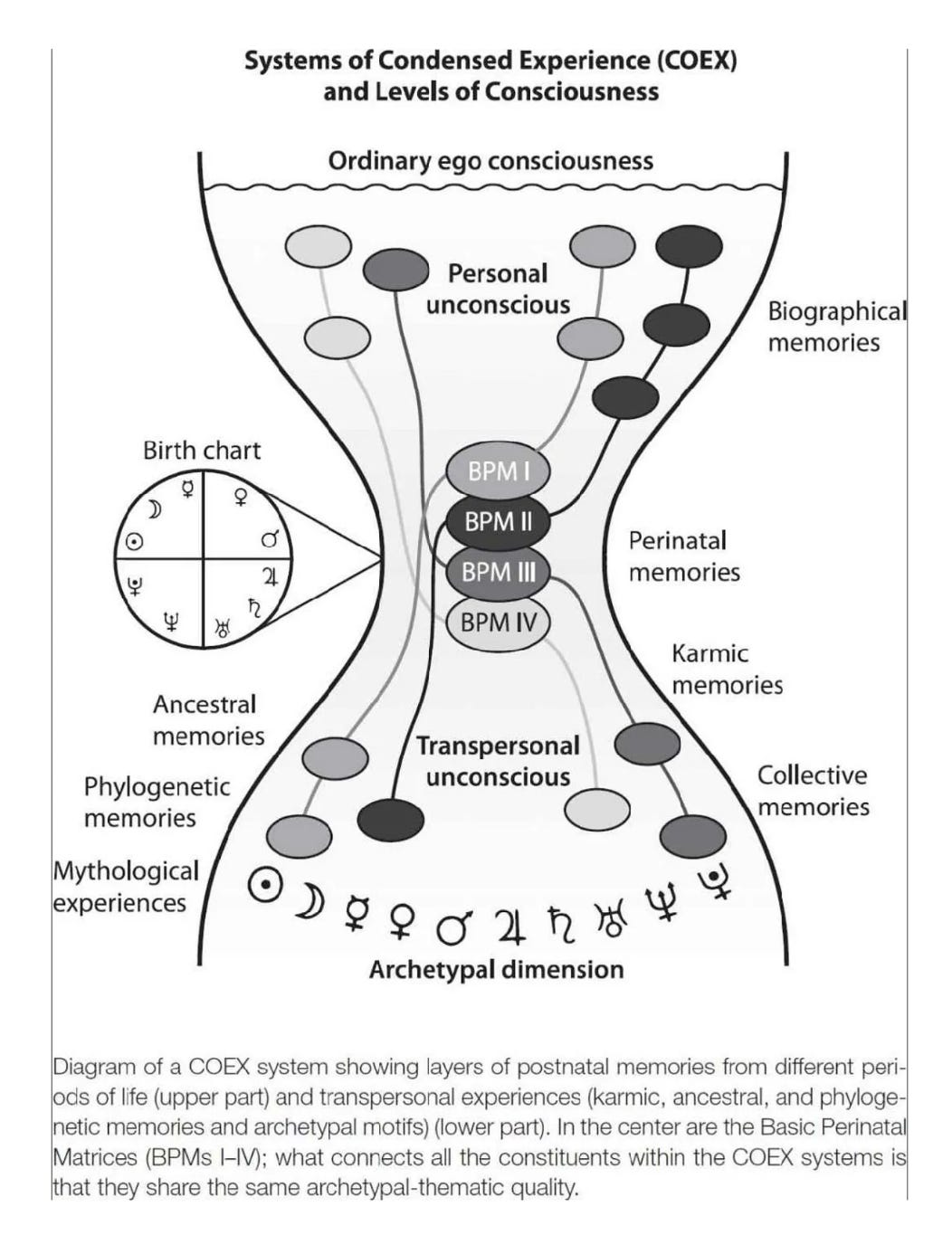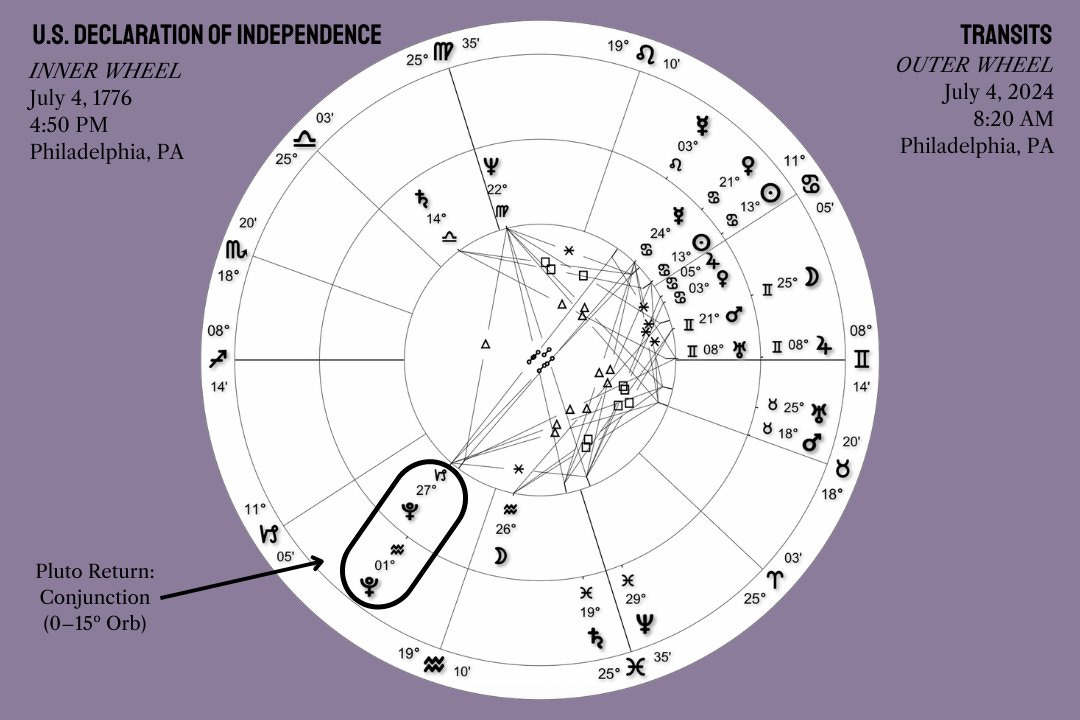The (Re)Birth of America
America has embarked on a hero's journey since its inception and now stands at a pivotal moment. What insights can cycles in history, finance, psychology, and cosmology offer about its trajectory?
Since its Declaration of Independence on July 4, 1776, the United States of America has embarked on a profound hero's journey— or rather, multiple journeys. As the next presidential election looms, the nation finds itself deeply divided, echoing a sense of unease reminiscent at the cusp of the Civil War in 1861. So can history–or shall I say "psychohistory"–tell us something about the nation's unfolding future?
Joseph Campbell, the author of The Hero with a Thousand Faces, introduced the concept of the hero's journey as a monomyth—a cyclical pattern that most if not all, cultural and religious mythologies follow. Like religions, nations are also built on values deeply embedded in a story, often that of a hero. So, let's dive into the American saga and find out where the hero is heading.
Settlement of the New World
America's "call to adventure" began when the first settlers from Europe arrived on the eastern shores of the continent in the early 1600s. Due to political, religious, and economic turmoil in their homelands, many Europeans voyaged across the Atlantic Ocean in search of life, liberty, and the pursuit of happiness.
As the settlers passed the threshold from known to unknown, Native Americans played the role of mentor and helper, teaching the settlers agricultural, hunting, trading, and building techniques essential for survival. And so, the structures of Western civilization were slowly being built on indigenous land, creating space and infrastructure for more colonists to arrive.
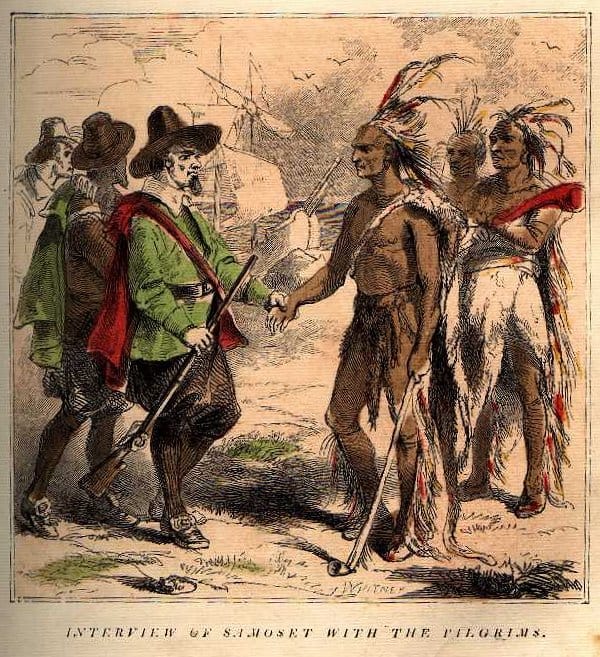
However, over time, tensions began to rise between the colonists and the indigenous people, eventually leading to a massive decline in the Native population due to war and disease. This moment can be symbolized as the "abyss" in the hero's journey—an encounter with a life-death struggle. For the colonists, this event led to the rebirth of a collective identity, which would reach a crescendo during the American Revolution.
The Declaration of Independence
For roughly 156 years, the settlers in America were governed by the British Empire, leading to deepening frustrations as high taxes imposed by the King became increasingly burdensome. While the desire for financial freedom was a significant grievance, it was the pursuit of Enlightenment ideas—natural rights, liberty, and democracy—that truly inspired colonists to challenge monarchical authority and seek self-determination. And thus, armed conflict between American colonists and British troops broke out as the American Revolution reached its height in 1775. This once again marks America's entry into the "abyss" and the second cycle of the hero's journey.
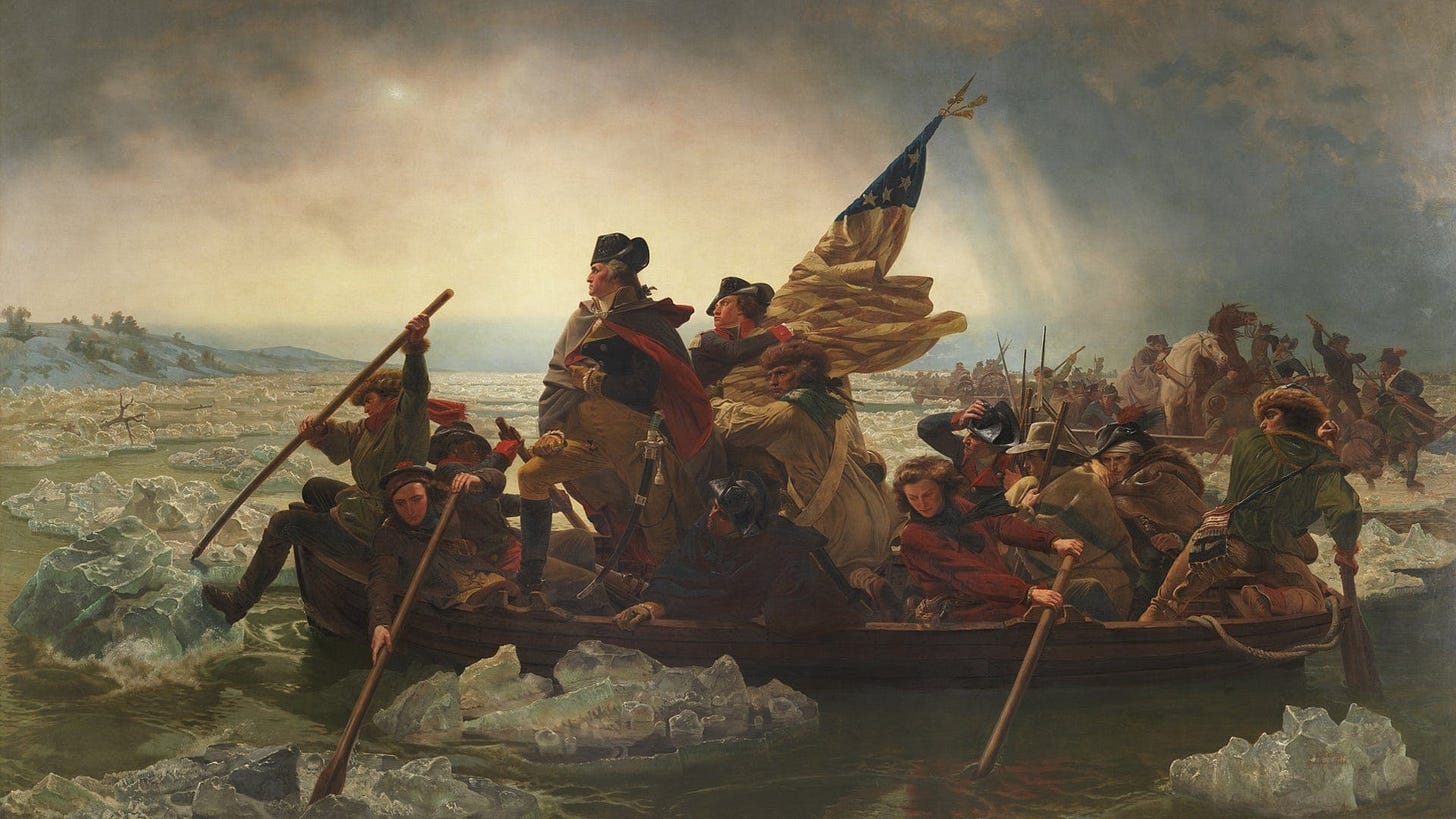
On July 4, 1776, America declared independence from British rule and achieved complete sovereignty as a democratic nation. This historic moment signifies the "return" in the hero's journey—America is yet again reborn with a new identity.
The 13th Amendment
The next major "abyss" came with the Civil War, spanning from 1861 to 1865. At its core was the contentious issue of slavery: the Union, under President Abraham Lincoln, aimed to abolish it, while the Confederacy, comprising 11 Southern states, fiercely defended the institution and asserted states' rights.
The war caused immense loss of life, but it eventually led to the abolition of slavery. Thus, America was reborn once more, this time with a profound commitment to equality and integrity embedded in its worldview and legal system.
D-Day
The fourth cycle and descent into the "abyss," occurred during World War II when America—as part of the Allies—fought the war against Nazi Germany and Japan. On June 6, 1944, now called D-Day, is the day when Allied forces launched a massive invasion on the beaches of Normandy, France. This operation marked a critical turning point in the war and ultimately led to the victory of the Allied forces.
The end of WWII marked the grand initiation of America as a rising power, putting into question the global authority of Great Britain.

The Macro Cycle
Thus far, I have categorized the American story into four major events, each coinciding with a war that led to the rebirth of America's identity. While each of these events can be considered part of four separate hero's journeys, if viewed from a broader perspective, it is possible to see the entire arc of American history until the end of WWII as one grand hero's journey.
The period of colonization literally symbolizes the first stage: the "call to adventure," as Europeans left their homeland and ventured West to establish a new home.
The next stage, "crossing the threshold," occurred during the American Revolution. It was a tremendous risk for American settlers to commit treason against the British Empire; however, with the aid of France, America emerged victorious and established itself as a sovereign nation.
The descent into the "abyss" is signified by the Civil War, as the internal conflict sought a rebirth of freedom within America.
The final stage, the "return," unfolded at the end of WWII when the Allied forces won and America became a global power. In Campbell's diagram, this can be considered the "Gift of the Goddess," as the nation embarked on a prosperous journey upward from that point onward.
The hero's journey never stops, which brings us to the current moment in America.
The Archetypical Rise and Fall
In his book The Changing World Order: Why Nations Succeed and Fail, Ray Dalio elucidates on the archetypical history of global empires, especially that of the past 500 years (Netherlands, United Kingdom, and the United States) to the potential and current rise of the next empire (China).
While I highly recommend reading the book for an in-depth understanding, you can watch this excellent 40-minute video summary by Ray Dalio himself:
n his detailed historical analysis, Dalio introduces an archetypical cycle that most empires follow (unconsciously). He proposes that there are roughly 18 indicators that enable us to measures the wealth and power of a nation, which he then categorizes into eight sections:
1) Education
2) Competitiveness
3) Innovation
4) Economic Output
5) Share of World Trade
6) Military Strength
7) Financial Center Strength
8) Reserve Currency Status
On this archetypical cycle, Dalio writes:
"To summarize, around the upward trend of productivity gains that produce rising wealth and better living standards, there are cycles that produce prosperous periods of building in which the country is fundamentally strong because there are relatively low levels of indebtedness, relatively small wealth, values, and political gaps, people working effectively together to produce prosperity, good education and infrastructure, strong and capable leadership, and a peaceful world order that is guided by one or more dominant world powers. These are the prosperous and enjoyable periods. When they are taken excess, which they always are, the excess lead to depressing periods of destruction and restructuring in which the country's fundamental weaknesses of high levels of indebtedness, large wealth, values, and political gaps, different factions of people unable to work well together, poor education and infrastructure, and the struggle to maintain an overextended empire under the challenge of emerging rivals lead to a painful period of fighting, destruction, and then a restructuring that establishes a new order, setting the stage for a new period of building."
So there is a rise, a crossing of the threshold to the top, a decline, and ultimately a new order. Therefore, Dalio's Archetypical Big Cycle can be mapped onto Campbell's Hero's Journey:
The "call to adventure" signifies the rise of a nation–a prosperous building period.
Stage 2, "crossing the threshold," signifies the top of the big cycle–the nation begins to face numerous limitations from loss of productivity to increasing wealth gaps.
The descent into the "abyss" signifies the decline–the nation undergoes a life-death struggle internally and externally.
The final stage, the "return," signifies the beginning of a new world order–a re-structuring takes place for the previous world order.
To further illustrate the archetypical rise and fall, the graph below shows the relative standing of the great empires of the past 500 years. As indicated, America reached its peak after World War II and has slowly been on a decline, while China seems to be on a steady incline.
It is also interesting to note that prior to the Dutch Empire, China was one of the world's most powerful empires. On the history of China, Dalio writes:
"Over most of last 1,400+ years most dynasties were very powerful, civilized, and cultured. Under the Tang Dynasty, China expanded its borders extensively and experienced a cultural flourishing; in the Northern and Southern Song Dynasties (from the 900s to the 1200s), China was the most innovative and dynamic economy in the world; in the Ming Dynasty (1300s to 1600s), China was a great power that enjoyed an extended wonderful period that was both very prosperous and very peaceful; and in the early Qing Dynasty (1600s to 1700s), China had its maximum territorial expansion, governing over a third of the world’s population while having an extremely strong economy. Then in the early 1800s and through the first half of the 1900s, China lost its power while European countries, and especially the British Empire, gained theirs."
While the graphs indicate a linear time horizon, the archetypical rise and fall of a nation could also be perceived through an upward-moving spiral. On this cyclical movement, Dalio writes:
"Evolution is the upward movement toward improvement that occurs because of adaptation and learning. Around it are cycles. To me, most everything transpires as an ascending trajectory of improvement with cycles around it, like an upward-pointing corkscrew:"
If China has been on an upward spiral journey, then perhaps America too, is on a cyclical journey of evolution. And so it seems, the hero's journey has a deeper telos.
The Perinatal Cycle
What causes the hero's journey to unfold in such a manner? Why is it so fundamental to the nature of life?
Well perhaps it has something to do with the most basic aspect of life: the creative process. So, let's dive deeper down the rabbit hole and find out what is brewing beneath the hero.
Stanislav Grof, one of the founders of Transpersonal Psychology, developed a new map of the human psyche. Building on the work of Sigmund Freud and Carl Jung, Grof expanded the depth psychological lineage to include not only the personal levels of the unconscious but also the perinatal and transpersonal realms. In his book The Psychology of the Future, Grof explains:
"In addition to the usual biographical level, two transbiographical realms: the perinatal domain, related to the trauma of biological birth; and the transpersonal domain, which accounts for such phenomena as experiential identification with other people, animals, plants, and other aspects of nature. The latter realm is also the source of ancestral, racial, phylogenetic, and karmic memories, as well as visions of archetypal beings and mythological regions. The extreme experiences in this category are identification with the Universal Mind and with the Supercosmic and Metacosmic Void. Perinatal and transpersonal phenomena have been described throughout the ages in the religious, mystical, and occult literature of various countries of the world."
Grof developed the Basic Perinatal Matrices (BPMs) which emerged from his research in Holotropic breathwork and psychedelic therapy. Through thousands of patient sessions, he identified recurring experiential patterns linked to the stages of birth. He found that these experiences could be grouped into four distinct matrices, each reflecting a phase of the birth process:
BPM I: Amniotic Universe - Represents the blissful prenatal state in the womb, characterized by unity and peace.
BPM II: Cosmic Oppression - Corresponds to the onset of labor, where the fetus feels trapped and experiences existential angst and despair.
BPM III: The Death-Rebirth Struggle - Represents the intense struggle during the birthing process, marked by aggressive and chaotic sensations.
BPM IV: The Death-Rebirth Experience - Symbolizes the successful completion of birth, leading to feelings of liberation, renewal, and connection to the larger cosmos.
The BPMs indicate, just as the hero's journey does, that hidden cyclical patterns profoundly influence human consciousness and behavior, shaping how each and every one of us responds to stress, trauma, and existential challenges throughout life.
Furthermore, Grof discovered that memories from the unconscious are not a "mosaic of isolated imprints," as traditional psychology may suggest. Rather, memories aggregate into a COEX system (system of condensed experience). Grof explains:
"A COEX system consists of emotionally charged memories from different periods of our life that resemble each other in the quality of emotion or physical sensation that they share. Each COEX system has a basic theme that permeates all its layers and represents their common denominator. The individual layers then contain variations on this basic theme that occurred at different periods of the person's life. The unconscious of a particular individual can contain several. COEX constellations. Their number and the nature of the central themes varies considerably from one person to another."
Thus, similar memories cluster to form archetypal imprints. The unconscious is filled with these archetypal patterns which dictate our conscious experiences and reactions.
Outer Planetary Archetypes
From Plato to Jung, the subject of archetypes has been of primal importance to the understanding of human psychology. The word "archetype" is derived from the Greek root "arkhe," which essentially means "the origin." In other words, archetypes are first principles.
When Grof and cultural historian Richard Tarnas first met at Esalen Institute in Big Sur, California in the 1970s, an archetypal renaissance unfolded. Their collaboration began in the context of researching non-ordinary states of consciousness, specifically within psychedelic therapy. The research led to the surprising discovery of the predictive power of astrology in determining the varied psychological states expressed in different individuals despite consuming the same dosage (in this case, LSD).
Tarnas found that an individual's birth chart, along with the current world transits, correlated significantly with their behavior during non-ordinary states of consciousness. As he investigated further, his research uncovered correlations beyond just the individual. Through his study of deep history, he found a significant correlation between planetary alignments and human affairs on Earth. Tarnas rediscovered a profound truth about the nature of reality and gave birth to the field of Archetypal Cosmology.
In his book Cosmos and Psyche: Imitations of a New World View, Tarnas provides a detailed analysis of Western history through the lens of planetary cycles, specifically focusing on the four outer planets: Saturn, Uranus, Neptune, and Pluto.
Saturn: the reality principle, structure, hard materiality, tradition, time, tribulations, isolation, character, wisdom, old age, death, solidity, and stability.
Uranus: the principle of change, freedom, rebellion, revolution, revelations, innovation, creativity, individuality, and eccentricity.
Neptune: the transcendent principle, imagination, spirituality, mysticism, ideals, beliefs, illusions, confusion, dreams, wholeness, fluidity, and the undivided ocean of consciousness.
Pluto: the principle of power, depth, intensity, primordial instincts, regenerative qualities, evolutionary processes, cycle of creativity and destruction, the mysterious, taboo, demonic, and transformative capacities.
These four outer planets are considered transpersonal planets because their orbital transits are much longer than those of the inner planets (e.g., Saturn has a 30-year cycle while Mars has a 2-year cycle). Thus, tracking the movements of the outer planets provides a macro perspective on our collective unfolding history on Earth.
Since the archetypes of the outer planets are transpersonal in nature, Tarnas and Grof were able to integrate their research into a comprehensive framework:
BPM 1 correlates with the archetype of Neptune as there is a sense of ease and harmony in this stage–the fetus is in the amniotic universe.
BPM 2 correlates with the archetype of Saturn as rigid contractions occur–the fetus feels oppressed and constricted.
BPM 3 correlates with the archetype of Pluto as labor begins–the fetus and mother are in a death-rebirth struggle.
BPM 4 correlates with the archetype of Uranus as the baby is born–a novel, creative entity has come into the world, and the mother is re-born into a new individual.
Here is a graph from Grof's book The Way of the Psychonaut which cohesively integrates the archetypal dimensions with the perinatal and personal dimensions of the unconscious:
While this diagram portrays the psyche of an individual, it can also be used to understand the psyche of a nation. Thus, it is evident that the psyche of America is embedded in layers of complexity, and the further we peel back these layers, the deeper our understanding of the current predicament becomes.
The Current Cycle
Thus far, we have uncovered that Joseph Campbell's Hero's Journey, Ray Dalio's Archetypical Big Cycle, Stanislav Grof's Basic Perinatal Matrices, and Richard Tarnas' Archetypal Cosmology correlate with each other. All these different frameworks come together in one cycle to provide a compelling view of the nature of reality. Ultimately, it seems clear that energy prefers to move in a certain way.
With this comprehensive framework, we can now investigate the current moment in America. The previous cycle ended with WWII and the rise of America as a global power. In the new cycle, we begin with the 1969 Moon Landing, as it was a pivotal moment for the nation, helping to further establish its dominance in the global landscape.

The Moon Landing was a "call to adventure" as Apollo 11 left the surface of the Earth and safely landed the first humans on the Moon. It represented "the rise" as competition and inventiveness flourished. It was the BPM 1/Neptune stage as the the country was reflecting a higher ideal to all other nations. America enjoyed three peaceful and prosperous decades thereafter. With the end of the Cold War in 1991, the nation's influence on the world increased dramatically as countries began to "Americanize" themselves.
However, at the turn of the 21st century, America was met with devastation. The 9/11 terrorist attacks shook the entire nation and called into question the country's defense system. This event signified "crossing the threshold" as America transitioned from the known world of peace to the unknown world of war. It marked "the top" of Dalio's cycle as the country became overextended, especially due to the "War on Terror," and began to lose its competitive edge. At this point, America entered the BPM II/Saturn stage, as it was experiencing painful contractions.
So then, since 2001 America has been on a descent into the "abyss." I believe this is the moment the nation is currently in but it is difficult to say whether the prominent event defining the third stage has occurred or not. Regardless, the prevailing sentiment—both internally and externally, as well as physically and emotionally—indicates that the country is in a perilous condition. Perhaps then, we can assume that America is in "the decline" stage experiencing the death-rebirth struggle of BPM III/Pluto.
Every 248 Years: The Pluto Cycle
British soldier and historian, Sir John Glub said: "The average age of the great civilizations of the world has been two hundred and fifty years. This average has not varied for five thousand years."
Providing further evidence, Ray Dalio said: "From examining all these cases across empires and across time, I saw that the great empires typically lasted roughly 250 years, give or take 150 years, with big economic, debt, and political cycles within them lasting about 50 to 100 years."
And so it seems there is consensus on the average lifespan of an empire. Ironically, Ray Dalio also mentioned this in his book, Big Debt Crises: "I find that whenever I start talking about cycles, particularly big, long-term cycles, people’s eyebrows go up; the reactions I elicit are similar to those I’d expect if I were talking about astrology. For that reason, I want to emphasize that I am talking about nothing more than logically-driven series of events that recur in patterns."
And yet, if you were to ask Dalio what is behind the archetypal cycle (i.e., why reality seems to continuously unfold in this cyclical manner), he would not be able to give you an answer, other than probably saying it is human nature.
It is no coincidence that the planet Pluto has a ~250-year orbital cycle. Pluto, the planetary archetype of evolutionary changes, creativity, destruction, death, and rebirth, correlates to the rise and fall of empires. Since it is America's 248th anniversary, the nation is in the midst of what is known as a "Pluto return," meaning that Pluto in the sky is now transiting over Pluto in the natal chart of the U.S. (the day it declared itself a sovereign nation).
The Pluto return indicates a rite of passage for the nation—an initiation into the deep, dark depths of civilization. The archetype of Pluto initiates destruction, but through this grueling process, it brings forth a deep creative spirit. It is up to the American people how best to participate with this titanic energy. But one thing is for sure: the nation is facing its own shadow. Lingering in the depths, Pluto exposes all that has been unconsciously buried. Thus, America is being asked to re-evaluate and rejuvenate itself in profound ways.
Through his study of history, Ray Dalio found that there is usually a 10–20 year period of transition from one empire to another. However, there is a possibility that transition need not occur, especially if the reigning nation manages to divert from the typical errors which cause "the decline."
Every 84 Years: The Uranus Cycle
While Pluto slowly moves out of orbit with America's natal Pluto, Uranus in the sky will begin transiting over the country's natal Uranus starting next year—initiating America's fourth Uranus return.
The Uranus return occurs every 84 years. In Cosmos & Psyche, Tarnas shares that the past two Uranus returns for America have coincided with major pivotal moments in U.S. history since the signing of the Declaration of Independence:
The beginning of the Civil War
The end of WWII
Synchronistically, Uranus was in the same position in the sky during these three periods as it was when the first English colony was established in Jamestown, Virginia, in 1607.
Although the incoming Uranus return will start to kick in 2025, it will be at its peak between 2026 and 2030. Thus, we can expect a major event to unfold towards the end of the 2020s that could reshape America's identity on the global stage.
Uranus reflects BPM IV and "the return" in the Hero's Journey. It represents a rebirth and awakening. While it is disruptive in nature, the archetype of Uranus propels itself toward freedom. Thus, whatever unfolds under this transit will ultimately lead to some kind of rebirth or liberation.
Maintaining and Evolving the Empire
America is experiencing re-birthing pains. It is clear that this is a nail-biting moment in the nation's history but it is unclear which trajectory it will take. With the next presidential election months away, a cloud of panic and disillusionment weighs over the American psyche. What can the country do to divert from a potential decline? How can it participate nobly with the deep, dark, and powerful energy of Pluto? And how might America prepare for its next Uranus return, knowing that all the previous ones coincided with major wars?
While Dalio may not "believe" in the reality of astrology, his overarching research does correlate with astrological dynamics. Thus, it seems as though there is a deep synchronicity at play. We can then assume Dalio's suggestions on how to best navigate the stormy seas are valuable and astrologically resonant as well. So here is an overview of the key indicators of a declining empire according to Dalio:
While interest rates have not hit 0%, money is being printed at an excessive rate. A major financial crisis has not yet occurred, but the wealth gap between the poor and the rich is only increasing. A major external conflict may be on the horizon, but for now, internal conflict—specifically between conservatives and liberals—is growing. On these issues and how it relates to the main characteristic of an empire, Dalio states:
“The United States is presently experiencing all three of the classic symptoms of a reserve currency at risk: mounting debt, internal conflict, and declining relative power. This puts the status of the U.S. dollar as the world’s primary reserve currency in jeopardy.”
Ultimately, the primary indicator that a country has achieved global empire status lies in its reserve currency status. The Dutch guilder yielded to the British pound, which in turn gave way to the US dollar, elevating it to the apex of the foreign currency hierarchy.
However, this status is gradually evolving. Entrepreneur and investor Balaji Srinivasan recently highlighted in a post that China has begun selling its U.S. bonds, signaling a potential precarious path ahead for America, given that a significant portion of the nation's debt is held by China:
Balaji is also a strong proponent of Bitcoin, suggesting that perhaps Bitcoin could become the world's next reserve currency, thereby potentially flipping this entire empire narrative on its head:
Maybe he is onto something, and we just might be entering a future in which there is no reigning empire but rather what Balaji calls a "network state"—a digital political entity formed by online communities with shared values and goals. It uses blockchain technology for decentralized governance and economic systems, aiming for sovereignty and recognition. While primarily existing online, network states can have physical manifestations. They serve as platforms for innovative governance, offering global reach and transcending traditional nation-state boundaries.
An unknown yet intriguing future lies ahead of us. While network states may continue to form and establish themselves with authority, I believe America still needs to do a lot of work to avoid potential catastrophic devastation. According to Dalio's six indicators, America will need to:
Address Income Inequality: Dalio emphasizes the importance of addressing the growing income inequality in the U.S. He suggests implementing policies that improve education and training for those in lower-income brackets and creating more opportunities for upward mobility.
Improve Education: Investing in education is crucial. Dalio advocates for reforms that ensure high-quality education for all, particularly in underfunded areas. This includes better funding for public schools, vocational training, and higher education.
Fiscal Responsibility: Dalio stresses the need for fiscal responsibility to manage the national debt and avoid unsustainable deficits. This involves prudent government spending, efficient allocation of resources, and reforming tax policies to ensure fairness and efficiency.
Political and Social Cohesion: Reducing political polarization and fostering social cohesion are essential for a stable and prosperous society. Dalio suggests focusing on common goals and values to bridge divides and promote unity.
Infrastructure Investment: Modernizing and expanding infrastructure is key to economic growth. Dalio recommends significant investments in transportation, technology, and other critical infrastructure sectors.
Innovation and Competitiveness: Encouraging innovation and maintaining global competitiveness are vital. Dalio supports policies that promote research and development, support emerging industries, and ensure the U.S. remains a leader in technological advancements.
Thus, the next president of the United States will need to roll up their sleeves and get to work. America requires a leader who is immensely practical, deeply compassionate, and wildly innovative to guide the nation on this profound odyssey.
Co-Creating the Moment
If you're an American citizen, or someone living in the U.S., then you're probably wondering "Well, what can I do?" With all these macro conditions and planetary cycles taking place, what can one individual do? Well, there is a famous Hermetic phrase:
"As above, so below; as within, so without; as the universe, so the soul."
Which means that what occurs on the personal level ripples out into the collective dimension and vice versa. So, the way in which you choose to participate in the unfolding reality will inevitably shape how that reality will concretize itself. If you're pessimistic about America and only complain about how terrible the nation is, then the country will imbue qualities of lack. If you're optimistic about America and proactively participate in ways that uplift the nation, then the country will radiate qualities of progress. On a similar note, this principle of Dalio's may be helpful:
“If you’re not worried, you need to worry. And if you’re worried, you don’t need to worry.”
My hope in writing this article is not to scare but to provide deeper context, and by doing so, perhaps inspire strength in those who felt things were happening randomly. So if you've been worried about the state of America, try not to worry so much and instead engage with the creative and powerful energies of the cosmos to bring out the version of America you want to see. And if you haven't been worried, then hopefully this article has given you a sense of where the nation may be heading and what it needs to do to avoid catastrophe. Mark Twain said, "History doesn't repeat itself, but it often rhymes." What if that rhyme is astrology?
I want to end by saying that we live in an open universe—nothing is predetermined. And astrology—despite its reputation for being deterministic—thrives in an open system. On the topic of free will and determinism, Tarnas writes:
“The more accurately one understands the archetypal forces that inform and affect one’s life, the more flexibly and intelligently responsive one can be in dealing with them. To the extent that one is unconscious of these potent and sometimes highly problematic forces, one is more or less a pawn of the archetypes, acting according to unconscious motivations with little possibility of being a co-creative participant in the unfolding and refining of those potentials. Archetypal awareness brings greater self-awareness and thus greater personal autonomy. Again, this is the basic rationale for depth psychology, from Freud and Jung onward: to release oneself from the bondage of blind action and unconsciously motivated experience, to recognize and explore the deeper forces in the human psyche and thereby modulate and transform them."
This is the power of Archetypal Astrology—the deeper we become aware of the first principles, the more capacity we have to shape how they manifest in reality. So if you haven't already, and are keen to unlock this part of your psyche, I highly recommend getting an Archetypal Astrology reading. It is the first initiation into this open, magnificent, and enchanting universe. Ultimately, the cosmos is made of creativity—the urge to go from nothing to everything. So I will leave you with this: create relentlessly. America just needs to be fueled up.
Cosmos bless America.






